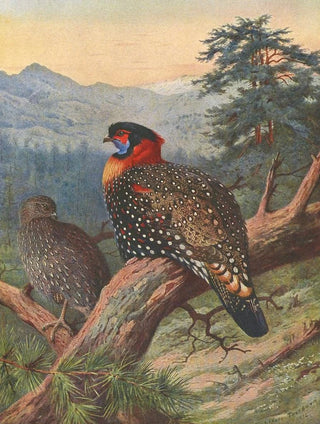Painting Tragopan occidental - Archibald Thorburn | Art print


View from behind

Frame (optional)
In the fascinating world of wildlife art, the "Western Tragopan" by Archibald Thorburn stands out for its beauty and depth. This painting, which depicts the tragopan, a majestic bird from the Himalayan forests, evokes not only the splendor of nature but also the delicacy of the artist's gaze on his subject. The work is an invitation to immerse oneself in a universe where fauna and flora meet, where every detail is carefully observed and rendered with remarkable precision. Through this art print, the viewer is transported into a vibrant world of colors and textures, revealing Thorburn's passion for nature and his commitment to capturing its fleeting beauty.
Style and uniqueness of the work
Archibald Thorburn's style is characterized by a realistic approach that demonstrates a deep respect for nature. In "Western Tragopan," the artist uses a palette of rich, nuanced colors to pay tribute to the bird's magnificence. Every feather, every reflection of light on the plumage is meticulously rendered, creating an illusion of life that captivates the observer. The composition of the work, with its lush foliage background, highlights the tragopan while integrating the bird into its natural habitat. Thorburn thus manages to establish a dialogue between the animal and its environment, emphasizing the harmony that exists in nature. This ability to combine scientific accuracy with artistic sensitivity gives his work a singularity that sets it apart in the landscape of wildlife art.
The artist and his influence
Archibald Thorburn, born in 1860, is recognized as one of the greatest naturalist artists of his time. His passion for ornithology, combined with his artistic talent, allowed him to create works that transcend simple animal representation. Thorburn dedicated his life to observing birds in their natural habitat, enabling him to capture moments of grace and beauty. His influence extends beyond his own works, inspiring many artists and naturalists. By integrating elements of science into his art, he paved the way for a new appreciation of

Matte finish

View from behind

Frame (optional)
In the fascinating world of wildlife art, the "Western Tragopan" by Archibald Thorburn stands out for its beauty and depth. This painting, which depicts the tragopan, a majestic bird from the Himalayan forests, evokes not only the splendor of nature but also the delicacy of the artist's gaze on his subject. The work is an invitation to immerse oneself in a universe where fauna and flora meet, where every detail is carefully observed and rendered with remarkable precision. Through this art print, the viewer is transported into a vibrant world of colors and textures, revealing Thorburn's passion for nature and his commitment to capturing its fleeting beauty.
Style and uniqueness of the work
Archibald Thorburn's style is characterized by a realistic approach that demonstrates a deep respect for nature. In "Western Tragopan," the artist uses a palette of rich, nuanced colors to pay tribute to the bird's magnificence. Every feather, every reflection of light on the plumage is meticulously rendered, creating an illusion of life that captivates the observer. The composition of the work, with its lush foliage background, highlights the tragopan while integrating the bird into its natural habitat. Thorburn thus manages to establish a dialogue between the animal and its environment, emphasizing the harmony that exists in nature. This ability to combine scientific accuracy with artistic sensitivity gives his work a singularity that sets it apart in the landscape of wildlife art.
The artist and his influence
Archibald Thorburn, born in 1860, is recognized as one of the greatest naturalist artists of his time. His passion for ornithology, combined with his artistic talent, allowed him to create works that transcend simple animal representation. Thorburn dedicated his life to observing birds in their natural habitat, enabling him to capture moments of grace and beauty. His influence extends beyond his own works, inspiring many artists and naturalists. By integrating elements of science into his art, he paved the way for a new appreciation of
12,34 €






